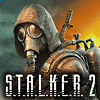 120
120
STALKER 2 Performance Benchmark Review - 35 GPUs Tested
(120 Comments) »Introduction
"Stalker 2: Heart of Chornobyl" marks the long-awaited return of the iconic S.T.A.L.K.E.R. series, arriving 15 years after the release of "Stalker: Call of Pripyat" in 2009. We finally get to go back to the legendary Zone, a radioactive wasteland warped by the aftermath of the Chernobyl disaster. The game takes you to a world full of dangerous enemies, rival factions, mutated creatures and deadly anomalies, uncovering the dark truths behind the Zone.With its dynamic open world, advanced survival mechanics, and branching storylines shaped by player choices, "Stalker 2: Heart of Chornobyl" revitalizes the beloved franchise with cutting-edge visuals and a gripping narrative. Combining survival horror with deep storytelling, this long-anticipated sequel captures the essence of the Stalker series while also introducing new layers of tension and immersion.

Stalker 2 is developed by GSC Game World—the famous Ukrainian game studio. Unreal Engine 5 is used, which has the ability to deliver stunning visuals as we've seen in other releases this year. While the first Stalker games used DirectX 9 and DirectX 10, this year's release is built with full support for DirectX 12. Unreal's "Lumen" technology is used, but only in the software, shader-based, version. Unfortunately there is no support for hardware ray tracing.
The full range of modern upscaling technologies is included, such as NVIDIA DLSS, AMD FSR and Intel XeSS. You also get frame generation support using AMD FSR or NVIDIA DLSS 3—both can be enabled and disabled separately.
This review will evaluate the performance of Stalker 2: Heart of Chornobyl across a wide range of contemporary graphics cards, compare image quality settings, and analyze the game's VRAM usage to provide insight into the hardware requirements needed for an optimal experience.
Screenshots
All screenshots were taken at the "Epic" settings profile, with all upscalers disabled. The gallery can be navigated with the cursor keys.Graphics Settings

- The "Graphics" menu has presets, which are "Low," "Medium," "High," and "Epic"
- Please do note that selecting any one of those profiles will set upscaling resolution to 66%!! This will look terrible at lower resolution, especially when using TAA. I've manually set it to 100% throughout this article
- You may disable motion blur by setting "Motion Blur Strength" to 0%
- Sharpness defaults to 20%, which is a reasonable default
- The upscalers available are "Off," "TAA," "TSR," "NVIDIA DLSS," "AMD FSR," and "Intel XeSS"
- DLAA and FSR Native are supported, by selecting "NativeAA" in "Upscaling quality"
- Both FSR and DLSS Frame Generation are supported. You may enable them separately, so GeForce 30 owners can use DLSS Upscaling with FSR Frame Generation
- In addition to that, there are several options for fine-tuning performance on your system

- You can choose between "fullscreen," "borderless," or "windowed"
- The field of view can be adjusted between 70 and 110 degrees. I found the default of 90° a little bit too narrow and increased it to 100°
- V-Sync can be disabled completely, there is no hidden FPS cap
- The FPS limiter can be set to 30, 60, 120, 240 and unlimited
- If the image is too dark for you, increase the Gamma setting. The default on my system was around 0.4, which made it extremely hard to see enemies and navigate the maps. After switching to 0.7, things were much more enjoyable
Our Patreon Silver Supporters can read articles in single-page format.
Apr 19th, 2025 00:04 EDT
change timezone
Latest GPU Drivers
New Forum Posts
- Looking for 4060 MXM-A VBIOS (11)
- GPU Memory Temprature is always high (19)
- (Some of) What I'd like to See From a Final Fantasy IX Remake (27)
- RX 9000 series GPU Owners Club (398)
- RTX5000 Series Owners Club (182)
- AsRock 9070 XT Taichi BIOS confusion (2)
- Dangerous RAM temps? (4)
- New PC: Instability and unexpected shutdowns when gaming. (6)
- Can Intel recover in DYI market anytime soon? (22)
- Need thoughts on a quiet PC that's great for rendering, video editing and office work... (1)
Popular Reviews
- ASUS GeForce RTX 5060 Ti TUF OC 16 GB Review
- NVIDIA GeForce RTX 5060 Ti PCI-Express x8 Scaling
- Palit GeForce RTX 5060 Ti Infinity 3 16 GB Review
- Teevolution Terra Pro Review
- ASUS GeForce RTX 5060 Ti Prime OC 16 GB Review
- MSI GeForce RTX 5060 Ti Gaming OC 16 GB Review
- Zotac GeForce RTX 5060 Ti AMP 16 GB Review
- MSI GeForce RTX 5060 Ti Gaming Trio OC 16 GB Review
- G.SKILL Trident Z5 NEO RGB DDR5-6000 32 GB CL26 Review - AMD EXPO
- ASRock X870E Taichi Lite Review
Controversial News Posts
- NVIDIA GeForce RTX 5060 Ti 16 GB SKU Likely Launching at $499, According to Supply Chain Leak (182)
- NVIDIA Sends MSRP Numbers to Partners: GeForce RTX 5060 Ti 8 GB at $379, RTX 5060 Ti 16 GB at $429 (127)
- Nintendo Confirms That Switch 2 Joy-Cons Will Not Utilize Hall Effect Stick Technology (105)
- NVIDIA Launches GeForce RTX 5060 Series, Beginning with RTX 5060 Ti This Week (103)
- Over 200,000 Sold Radeon RX 9070 and RX 9070 XT GPUs? AMD Says No Number was Given (100)
- Nintendo Switch 2 Launches June 5 at $449.99 with New Hardware and Games (99)
- Sony Increases the PS5 Pricing in EMEA and ANZ by Around 25 Percent (85)
- NVIDIA PhysX and Flow Made Fully Open-Source (77)



















































































































































